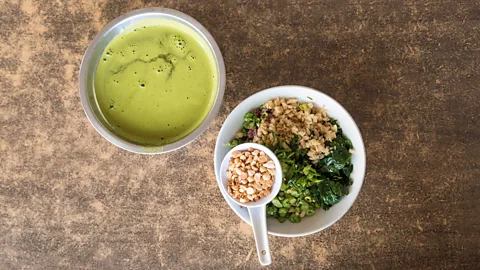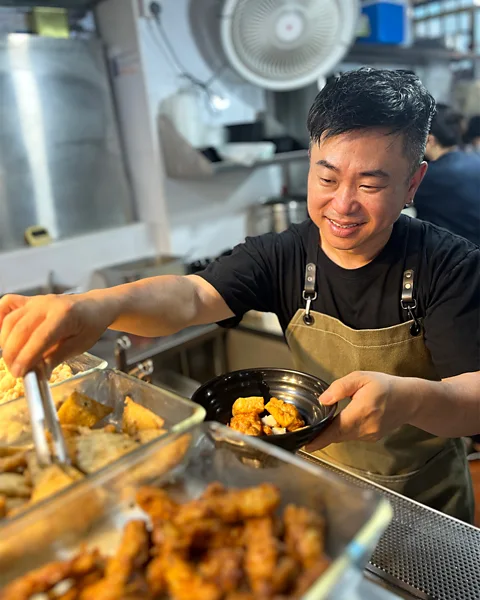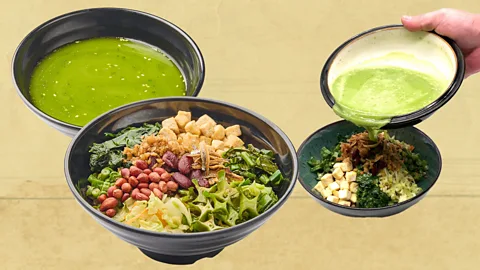Thunder tea rice: The 2,000-year-old healthy grain bowl
 Alamy
AlamyThousands of miles from where the 2,000-year-old grain bowl called lei cha, or "thunder tea rice", was first created in China, Hakka chef Pang Kok Keong has reworked the ancient delicacy in his Singapore kitchen for a new generation of healthy eaters.
Thunder tea rice – a bowl of rice topped with a balanced mix of vegetables, peanuts, dried fish and more, served alongside a boldy flavoured green "tea soup" – is a specialty of the Hakka people in Guangdong Province. The Hakka, of which there are many groups, originated in China's Central Plains. Over centuries of war, they migrated in many directions. In the 4th Century, they moved south to escape famine and war, making their home in the mountains. It was here they were given a new name by locals.
"[They were] called Kejia Ren (Guest People) because they do not have a province of their own," says anthropologist Dr Vivienne Wee. Centuries later, the Hakka journeyed further to countries such as Taiwan, Singapore, Malaysia and Indonesia, taking their recipes with them, including thunder tea rice.
At one time, Kok Keong Pang, a former award-winning French pastry chef and owner of Antoinette, one of Singapore’s most well-known patisseries (now closed), made a living by piping chocolate into macaron shells or calmly checking orders of violet mousse cakes garnished with black sugar. But when he turned 40, he started to think more about his heritage. Pang noticed that Hakka food outlets in Singapore were few and far between. He wanted to go back to his roots and make the herby green thunder tea rice and other dishes that he ate as a child.
Pang scoured the internet, bought books about Hakka culture and worked with his mother on perfecting heritage flavours. "She didn't have any recipes written down, so I would test something and let her try it," Pang says.
Most of the chefs that Pang worked with had Hakka heritage (it is the fourth largest Chinese dialect group in Singapore) but had not been exposed to Hakka food. When Pang told the French pastry chefs that he wanted to open a hawker stall, his team rose to the challenge.
World's Table
BBC.com's World's Table "smashes the kitchen ceiling" by changing the way the world thinks about food, through the past, present and future.
Pang knew the time was right. "Being a chef, you sort of have this superpower to create. With the knowledge that I have and with the research I had done, I thought I could do my part," Pang says.
In 2018, he opened Pang's Hakka Delicacies, one of two street food kitchens he now runs in Singapore. Thunder tea rice, made with Pang's own spin, is a highlight of the menu.
According to legend, the dish was created during the war of the Three Kingdoms from 220 CE to 280 CE when General Zhang Fei's soldiers fell ill with a mysterious plague before a battle. Thunder tea rice was prepared and prescribed by a doctor with much success as it boosted the soldiers' strength and immunity levels.
 Pang's Hakka Delicacies
Pang's Hakka DelicaciesToday, the power-packed dish capitalises on a growing interest in healthy rice bowls. Singaporean nutritionist Charlotte Mei explains that thunder tea rice is especially nourishing. "Grain bowls have this healthy halo around them, however, they don't contain a lot of leafy vegetables. What we have with the thunder tea rice is these dark green leafy vegetables that are really nutritious. They're high in antioxidants, and in some cases iron and calcium."
Pang attempts to prepare the dish as traditionally as possible. "For me it has always been to preserve the taste of Hakka food as I remember it," he says. The only modern shortcut that he takes is exchanging the pestle and mortar for a blender so he can quickly feed hungry customers.
Upon mounds of nutty brown rice, Pang serves salty ikan bilis (anchovies), roasted peanuts that have been charred to perfection and tangy preserved turnip, which is both salty and sweet. He places each topping separately over the rice in the bowl with the same precision that he once exercised at Antoinette.
Twists on Thunder Tea Rice
Pang is not the only chef to put his own spin on thunder tea rice. The new Barkar KL restaurant in Kuala Lumpur, owned by award-winning chefs Lee Zhe Xi and Soh Yong Zhi, pairs smoked fish with a lei cha granita. The MO Bar at the Mandarin Oriental Singapore serves the Thunder cocktail, a herbal drink inspired by the flavours of Hakka tea rice. The dish has also caught the attention of bloggers, including NomNom Princess, who recently chose to give her thunder tea rice a low-carb twist by using cauliflower rice.
The tea soup served alongside the rice is made from a ground paste of herbs, sesame, peanuts and sometimes oolong tea leaves, which Pang adds on request due to their strong flavour. He has refined the rustic paste he remembers from his youth by adjusting the levels of Thai basil, coriander and mugwort in the dish so it's not too bitter for a palate unaccustomed to the taste. Diners can dip their spoon into the rice and then the tea soup, or pour the herby pea-green soup directly over the grains.
When Hakka people make thunder tea rice at home it can often turn into a communal activity as family members share the tasks. Pang remembers the first time he saw the dish made in his Hakka grandmother's kitchen. "She would sit on a stool in the kitchen and hold what looked like an oversized pestle and mortar with her legs. Then using both hands she would use a giant guava stick to grind the tea paste," Pang says.
More like this:
• The world's sixth 'Blue Zone': Why Singapore values both quantity and quality of life
• From luxe to quirky and fun, the five best dim sum spots in Singapore
While some believe the name "thunder tea" comes from the sound that the pestle and mortar made when the herbs were being ground, Kim Kit Ow, author of Delicious Heirlooms, a book that focuses on hawker food, says, "The name of the dish is believed to come from the word 'lui' or 'lei', which means 'grind' in Hakka dialect and 'thunder' in Mandarin."
Pang’s homage to Hakka food is helping to put thunder tea rice in the spotlight, but he has also taken time to learn and replicate other dishes from the Hakka communities. His menu includes the abacus seed dumplings that are rarely seen in Singapore as well as another heritage dish called yong tau foo (stuffed tofu). Living in mountainous areas and unable to find wheat, the Hakka people made dumplings by stuffing fish and meat paste into chunks of tofu.
Pang has a sense of nostalgia when replicating dishes he remembers from his youth, but at the same time he wants them to be a part of Singapore's future. "I think to understand a culture, the best way is through the food," he says. "I am doing what I can to preserve the little Hakka culture that Singapore has now."
 Pang's Hakka Delicacies
Pang's Hakka DelicaciesThunder Tea Rice recipe
By Chef Pang Kok Keong
Serves 10-12
Ingredients
For the tea paste:
140g Thai basil leaves
60g mint leaves
30-60g mugwort leaves (depending on how intense you enjoy the bitter taste)
30g Chinese coriander stems and leaves
60g roasted peanuts
40g roasted sesame seeds
8g oolong tea leaves (optional)
700ml ice water
Salt to taste
For the toppings:
Choose five or more toppings to create variety. Make sure each topping can be scooped up easily with a spoon.
15-20g Hong Kong kailan, chopped
15-20g long beans, diced
15-20g wing beans, sliced
15-20g cabbage, sliced
15-20g salted preserved turnips
7g ikan bilis (anchovies)
10-15g peanuts, roasted and shelled
15-20g deep fried tofu, diced
Oil, for frying
Salt for seasoning
To serve:
150g cooked brown rice or white rice per person
Boiling water
Method
Step 1
Make the tea paste: Blanch the herbs in boiling water and shock in a bowl of ice water. Strain and squeeze dry. Roughly chop the herbs so they're easier to blend. Add the herbs and remaining ingredients to a blender and blend until smooth; season with salt.
Step 2
Prepare the toppings: Heat a little oil in a wok. Fry the kalian, long beans, wing beans and cabbage quickly at high heat and add a little water so they cook evenly. It may splatter slightly. Season with salt. Take out of the wok and set aside. Saute the salted preserved turnips in a little oil until fragrant. Deep fry the ikan bilis till crispy.
Step 3
Place each serving of tea paste (150-200g) into individual bowls. (Excess can be frozen in resealable plastic bags.) Scoop the hot rice into deep soup bowls. Arrange your chosen toppings over the rice.
Step 4
In a separate bowl, pour boiling water over the tea paste in the bowls (the amount of water depends on how strong you like the soup). You can eat the soup separately or pour it over the rice.
--
If you liked this story, sign up for The Essential List newsletter – a handpicked selection of features, videos and can't-miss news, delivered to your inbox twice a week.
